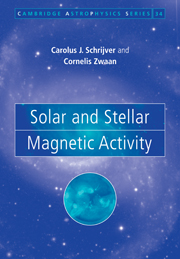Book contents
- Frontmatter
- Contents
- Preface
- 1 Introduction: solar features and terminology
- 2 Stellar structure
- 3 Solar differential rotation and meridional flow
- 4 Solar magnetic structure
- 5 Solar magnetic configurations
- 6 Global properties of the solar magnetic field
- 7 The solar dynamo
- 8 The solar outer atmosphere
- 9 Stellar outer atmospheres
- 10 Mechanisms of atmospheric heating
- 11 Activity and stellar properties
- 12 Stellar magnetic phenomena
- 13 Activity and rotation on evolutionary time scales
- 14 Activity in binary stars
- 15 Propositions on stellar dynamos
- Appendix I Unit conversions
- Bibliography
- Index
5 - Solar magnetic configurations
Published online by Cambridge University Press: 14 August 2009
- Frontmatter
- Contents
- Preface
- 1 Introduction: solar features and terminology
- 2 Stellar structure
- 3 Solar differential rotation and meridional flow
- 4 Solar magnetic structure
- 5 Solar magnetic configurations
- 6 Global properties of the solar magnetic field
- 7 The solar dynamo
- 8 The solar outer atmosphere
- 9 Stellar outer atmospheres
- 10 Mechanisms of atmospheric heating
- 11 Activity and stellar properties
- 12 Stellar magnetic phenomena
- 13 Activity and rotation on evolutionary time scales
- 14 Activity in binary stars
- 15 Propositions on stellar dynamos
- Appendix I Unit conversions
- Bibliography
- Index
Summary
Active regions
The concentrations of strong magnetic field occur in characteristic time-dependent configurations. A prominent configuration is the bipolar active region, which is formed during the emergence of strong magnetic flux. Around the time of its maximum development, a large active region comprises sunspots, pores, and faculae arranged in plages and enhanced network (Fig. 1.2). In this book, the term active region is used to indicate the complete area within a single, smooth contour that just includes all its constituents. We prefer the term active region over the older term center of activity. Classical descriptions of active regions are found in Kiepenheuer (1953, his Section 4.12), De Jager (1959), and Sheeley (1981).
The present chapter is restricted to simple bipolar active regions. Throughout this book we use the term bipolar active region for regions consisting of only two fairly distinct areas of opposite polarity, in contrast with complex active regions in which at least one of the polarities is distributed over two or more areas. Bipolar active regions are building blocks in complex active regions and nests (Section 6.2.1).
At maximum development, directly after all magnetic flux has emerged, bipolar active regions range over some 4 orders of magnitude in magnetic flux, size, and lifetime; see Table 5.1. The division between small active regions and ephemeral active regions is based on an arbitrary historical choice: there is no qualitative difference between the two groups of bipolar features other than gradual trends.
- Type
- Chapter
- Information
- Solar and Stellar Magnetic Activity , pp. 114 - 136Publisher: Cambridge University PressPrint publication year: 2000

